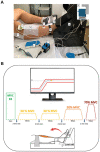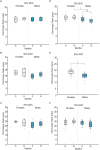Sex-differences in the longitudinal recovery of neuromuscular function in COVID-19 associated acute respiratory distress syndrome survivors
- PMID: 37435534
- PMCID: PMC10330713
- DOI: 10.3389/fmed.2023.1185479
Sex-differences in the longitudinal recovery of neuromuscular function in COVID-19 associated acute respiratory distress syndrome survivors
Abstract
Introduction: Patients admitted to the intensive care unit (ICU) following severe acute respiratory syndrome 2 (SARS-CoV-2) infection may have muscle weakness up to 1 year or more following ICU discharge. However, females show greater muscle weakness than males, indicating greater neuromuscular impairment. The objective of this work was to assess sex differences in longitudinal physical functioning following ICU discharge for SARS-CoV-2 infection.
Methods: We performed longitudinal assessment of physical functioning in two groups: 14 participants (7 males, 7 females) in the 3-to-6 month and 28 participants (14 males, 14 females) in the 6-to-12 month group following ICU discharge and assessed differences between the sexes. We examined self-reported fatigue, physical functioning, compound muscle action potential (CMAP) amplitude, maximal strength, and the neural drive to the tibialis anterior muscle.
Results: We found no sex differences in the assessed parameters in the 3-to-6-month follow-up, indicating significant weakness in both sexes.Sex differences emerged in the 6-to-12-month follow-up. Specifically, females exhibited greater impairments in physical functioning, including lower strength, walking lower distances, and high neural input even 1 year following ICU-discharge.
Discussion: Females infected by SARS-CoV-2 display significant impairments in functional recovery up to 1 year following ICU discharge. The effects of sex should be considered in post-COVID neurorehabilitation.
Keywords: COVID-19; intensive care unit; motor unit; neuromuscular function; sex differeces.
Copyright © 2023 Lulic-Kuryllo, Benedini, Cogliati, Cudicio, Guarneri, Gazzina, Piva, Latronico, Orizio and Negro.
Conflict of interest statement
The authors declare that the research was conducted in the absence of any commercial or financial relationships that could be construed as a potential conflict of interest.
Figures



Similar articles
-
Electrophysiological neuromuscular alterations and severe fatigue predict long-term muscle weakness in survivors of COVID-19 acute respiratory distress syndrome.Front Neurol. 2023 Nov 22;14:1235734. doi: 10.3389/fneur.2023.1235734. eCollection 2023. Front Neurol. 2023. PMID: 38073634 Free PMC article.
-
Muscle weakness, functional capacities and recovery for COVID-19 ICU survivors.BMC Anesthesiol. 2021 Mar 2;21(1):64. doi: 10.1186/s12871-021-01274-0. BMC Anesthesiol. 2021. PMID: 33653264 Free PMC article.
-
Intensive Care Unit- Acquired Weakness and Hospital Functional Mobility Outcomes Following Invasive Mechanical Ventilation in Patients with COVID-19: A Single-Centre Prospective Cohort Study.J Intensive Care Med. 2022 Aug;37(8):1005-1014. doi: 10.1177/08850666221100498. Epub 2022 May 16. J Intensive Care Med. 2022. PMID: 35578542 Free PMC article.
-
Long-term clinical outcomes in survivors of severe acute respiratory syndrome and Middle East respiratory syndrome coronavirus outbreaks after hospitalisation or ICU admission: A systematic review and meta-analysis.J Rehabil Med. 2020 May 31;52(5):jrm00063. doi: 10.2340/16501977-2694. J Rehabil Med. 2020. PMID: 32449782
-
Convalescent plasma or hyperimmune immunoglobulin for people with COVID-19: a rapid review.Cochrane Database Syst Rev. 2020 May 14;5(5):CD013600. doi: 10.1002/14651858.CD013600. Cochrane Database Syst Rev. 2020. Update in: Cochrane Database Syst Rev. 2020 Jul 10;7:CD013600. doi: 10.1002/14651858.CD013600.pub2. PMID: 32406927 Free PMC article. Updated.
Cited by
-
Electrophysiological neuromuscular alterations and severe fatigue predict long-term muscle weakness in survivors of COVID-19 acute respiratory distress syndrome.Front Neurol. 2023 Nov 22;14:1235734. doi: 10.3389/fneur.2023.1235734. eCollection 2023. Front Neurol. 2023. PMID: 38073634 Free PMC article.
-
Muscle weakness after critical illness: unravelling biological mechanisms and clinical hurdles.Crit Care. 2025 Jun 17;29(1):248. doi: 10.1186/s13054-025-05462-z. Crit Care. 2025. PMID: 40528196 Free PMC article. Review.
References
LinkOut - more resources
Full Text Sources
Miscellaneous

